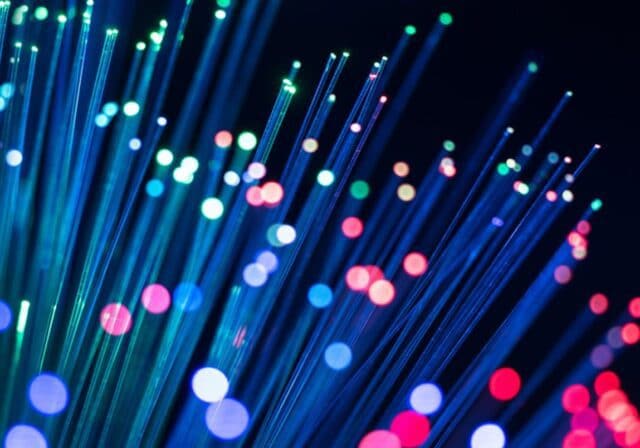We're here to help clear it all up so you have a better idea of what it is, how it works, and why everyone seems to be talking about it.
What is fiber optics?
Fiber optics is a technology that uses thin strands of glass or plastic fibers to transmit data as pulses of light. It's commonly used for high-speed, long-distance communication because it has a much greater bandwidth1 than the metal cables of yesteryear and is less susceptible to interference 2.
How does fiber optic internet work?
Also called fiber broadband, or fiber internet, it uses light to transmit information to your home. Fiber-optic lines send data via light signals, giving your home internet what may seem like warp-speed capabilities. Unlike older internet infrastructure technologies like DSL (e.g., phone lines), one single fiber cable can carry hundreds of thousands of voice circuits and it's immune to electrical interference 2. In addition, with fiber, you usually get equal speeds for uploads and downloads, whereas cable internet often has far less uploading power, making fiber capabilities impressive, especially if you have a lot of people who work from home, share large files, or back-up a lot of data in the cloud.
How does fiber internet get into my home?
The best type of fiber-optic connection is called "fiber-to-the-home" (FTTH), which means the fibers come straight to your modem. T-Mobile Fiber offers its customers this type of connection. Also important is the type of Wi-Fi router you connect to it. Wi-Fi 6, for example, is an advanced generation of Wi-Fi technology that offers greater speeds than its predecessor. It makes it possible to deliver Wi-Fi to multiple devices simultaneously without the congestion that previous generations of Wi-Fi often experienced—which means it may be a great choice for households full of smart appliances and a bevy of other connected devices.
T‑Mobile Fiber customers get a Wi-Fi 6 router included with service for no additional cost. While T-Mobile Fiber isn't offered everywhere just yet, service is expanding. You can check to see if it's available in your area here.
How is fiber internet different from 5G home internet?
While fiber internet may be a smart choice for some people, other customers are happy with cutting the cord and opting for wireless 5G home internet. For example, T-Mobile Home Internet utilizes a 5G Wi-Fi gateway device in tandem with Wi-Fi 6 technology to keep you connected at home. The device is controlled via a convenient app and, since it's wireless, you can set it up in minutes hassle free. Best of all, it's more widely available right now, it's budget friendly, and it has no annual service contract or hidden fees. You can check here to see if it's available in your area and try it out for 15 days, no strings attached.
Sources:
- https://www.fcc.gov/consumers/guides/getting-broadband-qa
- https://www.gartner.com/en/information-technology/glossary/fiber-optics
Additional Sources:
- https://www.gartner.com/en/glossary/
- https://www.c1c.net/blog/the-pros-cons-and-difference-between-cable-and-fiber-optic-internet/
- https://t-mobilefiber.com/fiber-internet-service/benefits-of-fiber-internet-speed-and-wifi-6
- https://www.techtarget.com/searchnetworking/definition/fiber-to-the-home
- https://www.ncbi.nlm.nih.gov/pmc/articles/PMC3146387/#:~:text=Charles%20Kuen%20Kao%20is%20known,communication%20in%20the%20Information%20Age.
- https://www.nature.com/articles/s41566-021-00812-z
- https://www.t-mobile.com/news/community/25-new-towns-selected-to-receive-t-mobile-hometown-grants-for-local-initiatives
